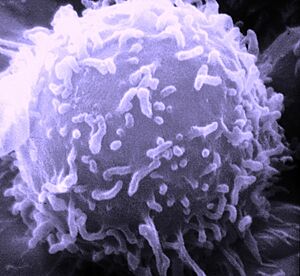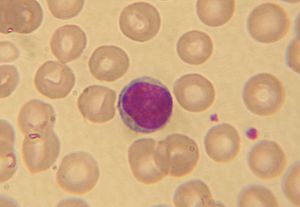Lymphocyte facts for kids

Lymphocytes are a special type of white blood cell that helps your body fight off infections. Think of them as tiny soldiers in your immune system! All animals with a backbone (like humans, birds, and fish) have them. Each lymphocyte has a big, round center called a nucleus.
There are three main kinds of lymphocytes:
- Natural killer (NK) cells
- T cells
- B cells
Contents
How Lymphocytes Protect You
Natural Killer Cells: Your Body's First Responders
Natural killer (NK) cells are part of the immune system you're born with. They are like your body's immediate defense team. Their job is to protect you from tumours (abnormal growths) and cells that have been infected by viruses.
When cells in your body get damaged or infected, they release special chemicals called interferons. These chemicals tell the NK cells to get ready for action! NK cells are smart; they can tell the difference between healthy cells and sick or dangerous ones. They look for changes on the surface of cells.
Once an NK cell finds a bad cell, it releases tiny packets of chemicals called granules. These granules are like tiny bombs that destroy the unhealthy cells, keeping your body safe.
T and B Cells: The Smart Defenders
T cells and B cells are the main players in your body's "adaptive" immune system. This means they learn and remember past infections. They are super important for fighting off invaders and making sure your body remembers them for next time.
The main job of T cells and B cells is to spot foreign things called antigens. Antigens are like unique ID tags on the surface of cells, bacteria, or viruses. When T and B cells find an invader with a foreign antigen, they work to get rid of it.
- B cells fight invaders by making lots of special proteins called antibodies. Antibodies are like tiny handcuffs that grab onto foreign objects, marking them for destruction.
- T cells have different roles:
* Some T cells, called T helper cells, produce signals called cytokines. These signals tell other immune cells that there's an invader and guide the immune response. * Other T cells, called cytotoxic T cells, are like assassins. They produce toxic granules that directly kill infected cells.
Once T and B cells have fought off an infection, they create "memory cells." These memory cells live for a long time in your body. If the same invader comes back, these memory cells quickly remember it and launch a strong, fast attack. This is how vaccinations work – they teach your memory cells about a germ so you can fight it off later!
How Lymphocytes Grow
All blood cells, including lymphocytes, start from special cells called stem cells in your bone marrow. This process is called haematopoiesis, which means "blood growth." All lymphocytes begin as a basic lymphocyte cell before they change into their specific types.
B cells finish growing in the bone marrow. T cells, however, travel to a special organ called the thymus to mature. After they are fully grown, lymphocytes move around your body in your blood and through special "lymphoid organs" like the spleen and lymph nodes. This allows them to quickly find and fight invading pathogens (germs) and tumour cells.
Lymphocytes and Your Health
When doctors check your blood, they often count the number of lymphocytes. This is called a lymphocyte count.
- If you have a lot of lymphocytes, it often means your body is fighting a virus infection. In very rare cases, a very high count can be a sign of a blood cancer called leukemia.
- If you have a low number of lymphocytes, it might happen after surgery or a serious injury.
The Human immunodeficiency virus (HIV) is a serious virus that attacks and destroys T cells. Without enough T cells, your body can't fight off infections that a healthy person would easily handle. Doctors can check how much HIV has affected a person by measuring a specific type of T cell (called CD4+ T cells) in their blood. Counting lymphocytes also helps doctors understand other virus infections or blood problems.
Images for kids
-
A scanning electron microscope image of normal circulating human blood showing red blood cells, several types of white blood cells including lymphocytes, a monocyte, a neutrophil and many small disc-shaped platelets
See also
 In Spanish: Linfocito para niños
In Spanish: Linfocito para niños






